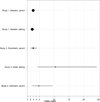Family history of schizophrenia and bipolar disorder as risk factors for autism
- PMID: 22752149
- PMCID: PMC4187103
- DOI: 10.1001/archgenpsychiatry.2012.730
Family history of schizophrenia and bipolar disorder as risk factors for autism
Abstract
Context: The clinical and etiologic relation between autism spectrum disorders (ASDs) and schizophrenia is unclear. The degree to which these disorders share a basis in etiology has important implications for clinicians, researchers, and those affected by the disorders.
Objective: To determine whether a family history of schizophrenia and/or bipolar disorder is a risk factor for ASD.
Design, setting, and participants: We conducted a case-control evaluation of histories of schizophrenia or bipolar disorder in first-degree relatives of probands in 3 samples—population registers in Sweden, Stockholm County (in Sweden), and Israel. Probands met criteria for ASD, and affection status of parents and siblings for schizophrenia and bipolar disorder were established.
Results: The presence of schizophrenia in parents was associated with an increased risk for ASD in a Swedish national cohort (odds ratio [OR], 2.9; 95% CI, 2.5-3.4) and a Stockholm County cohort (OR, 2.9; 95% CI, 2.0-4.1). Similarly, schizophrenia in a sibling was associated with an increased risk for ASD in a Swedish national cohort (OR, 2.6; 95% CI, 2.0-3.2) and an Israeli conscription cohort (OR, 12.1; 95% CI, 4.5-32.0). Bipolar disorder showed a similar pattern of associations but of lesser magnitude.
Conclusions: Findings from these 3 registers along with consistent findings from a similar study in Denmark suggest that ASD, schizophrenia, and bipolar disorder share common etiologic factors.
Conflict of interest statement
The authors report no conflicts.
Figures
References
-
- American Psychiatric Association. Diagnostic and Statistical Manual of Mental Disorders. Fourth Edition ed. Washington, DC: American Psychiatric Association; 1994.
-
- World Health Organization. The ICD-10 Classification of Mental and Behavioural Disorders: Diagnostic Criteria for Research. Geneva: World Health Organization; 1993.
-
- Rutter M. Childhood schizophrenia reconsidered. J Autism Child Schizophr. 1972;2(4):315–337. - PubMed
-
- Bleuler E. Dementia Praecox or the Group of Schizophrenias. New York: International Universities Press; 1952.
-
- McNally K. Eugene Bleuler's four As. Hist Psychol. 2009;12(2):43–59. - PubMed
Publication types
MeSH terms
Grants and funding
LinkOut - more resources
Full Text Sources
Other Literature Sources
Medical
Miscellaneous


